新视野大学英语第二册(第三版)教案
(完整版)新视野大学英语第二册(第三版)教案
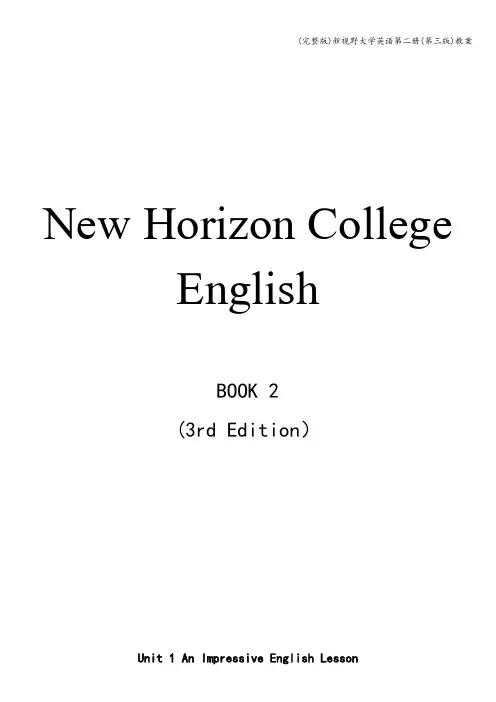
New Horizon CollegeEnglishBOOK 2(3rd Edition)Unit 1 An Impressive English Lesson课型:□ 理论课√ 理论、实践课□ 实践课课时分配: 6教学环境:多媒体教室教学目标:After studying this unit, the students are expected to be able to:1. understand the main idea and structure of Section A and Section B;2. master the key language points and grammatical structures in the texts3。
talk about language teaching and learning and express their opinions about current way of teaching in an English class;4. read with the skill ―finding key ideas in sentences;5. write a composition with three main parts: introduction, body and conclusion. Key Issues:1. VocabularyTedious, absorbed, allergic, capture, condense, exceed, distinguish, distinctive, complimentary, complementary, proclaim, evidently, adequate, competent,adjust, beneficial2。
SkillsLearn to read with the skill ―finding key ideas in sentences and write a composition with three main parts: introduction, body and conclusion.Potential Problems and Difficulties●To talk about language teaching and learning●write a composition with three main parts: introduction, body and conclusion。
大学英语c2的课本教案
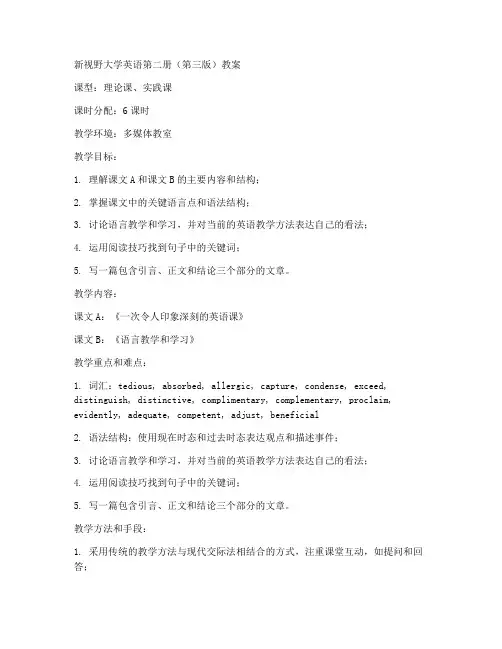
新视野大学英语第二册(第三版)教案课型:理论课、实践课课时分配:6课时教学环境:多媒体教室教学目标:1. 理解课文A和课文B的主要内容和结构;2. 掌握课文中的关键语言点和语法结构;3. 讨论语言教学和学习,并对当前的英语教学方法表达自己的看法;4. 运用阅读技巧找到句子中的关键词;5. 写一篇包含引言、正文和结论三个部分的文章。
教学内容:课文A:《一次令人印象深刻的英语课》课文B:《语言教学和学习》教学重点和难点:1. 词汇:tedious, absorbed, allergic, capture, condense, exceed, distinguish, distinctive, complimentary, complementary, proclaim, evidently, adequate, competent, adjust, beneficial2. 语法结构:使用现在时态和过去时态表达观点和描述事件;3. 讨论语言教学和学习,并对当前的英语教学方法表达自己的看法;4. 运用阅读技巧找到句子中的关键词;5. 写一篇包含引言、正文和结论三个部分的文章。
教学方法和手段:1. 采用传统的教学方法与现代交际法相结合的方式,注重课堂互动,如提问和回答;2. 分组讨论和配对练习,鼓励学生积极参与,提高他们的口语表达能力;3. 提供视觉辅助材料、投影仪、立体声和麦克风等教学工具,帮助学生更好地理解课文和进行讨论;4. 引导学生进行课外学习,提供更多的指导和支持。
教学过程:第一课时:一、导入(5分钟)1. 问候和热身问题讨论:什么是帮助人们学习英语的关键因素?你在英语学习中有没有遇到过问题?你认为语法在英语学习中重要吗?二、听力练习(15分钟)1. 听力练习:听一段关于英语教学和学习的谈话,并回答相关问题。
第二课时:一、课文A:《一次令人印象深刻的英语课》(25分钟)1. 阅读课文A,理解主要内容和结构;2. 讨论课文A中的关键语言点和语法结构;3. 练习使用课文A中的词汇和语法结构进行口语表达。
新视野大学英语阅读2(第三版)完整教案
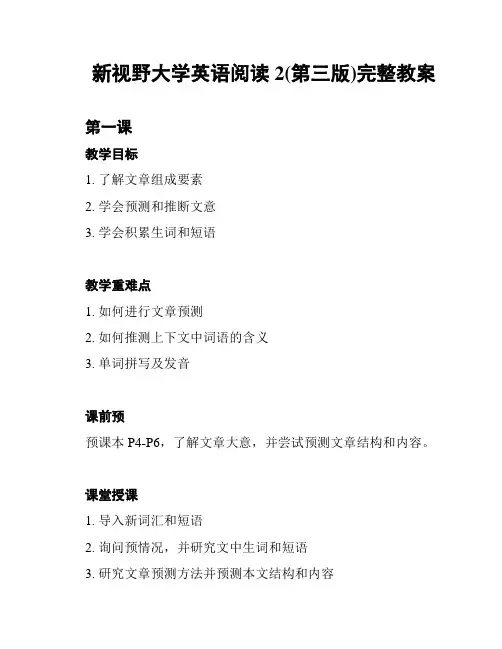
新视野大学英语阅读2(第三版)完整教案
第一课
教学目标
1. 了解文章组成要素
2. 学会预测和推断文意
3. 学会积累生词和短语
教学重难点
1. 如何进行文章预测
2. 如何推测上下文中词语的含义
3. 单词拼写及发音
课前预
预课本P4-P6,了解文章大意,并尝试预测文章结构和内容。
课堂授课
1. 导入新词汇和短语
2. 询问预情况,并研究文中生词和短语
3. 研究文章预测方法并预测本文结构和内容
4. 细读文章,推测上下文词语含义
5. 汇总文章重点及难点词汇并练单词拼写和发音
课后作业
1. 完成课本P7的词汇练
2. 搜集并整理本单元的重点和难点词汇
第二课
教学目标
1. 学会通过重读和语调标出句子中的重点
2. 练用简单英语对日常活动进行描述
教学重难点
1. 句子重点的标注方法
2. 描述日常生活的基本词汇和短语
课前预
预课本P8-P10,并准备描述自己的日常活动
课堂授课
1. 导入新词汇和短语
2. 询问预情况,并进行简单日常活动描述练
3. 研究句子重点标注方法,并练标注句子重点
4. 分组练日常活动对话,并标注句子重点
课后作业
1. 练使用句子重点标注方法
2. 自行收集日常活动描述中的重点和难点词汇。
新视野大学英语第三版2
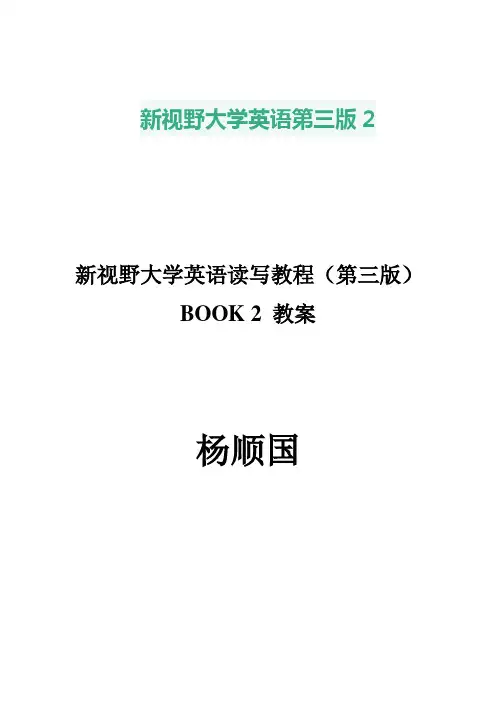
教学方法
Methodology
A combination of traditional teaching methods with the communicative approach will be adopted. Special attention should be paid to classroom interaction like questioning and answers. Small group works are alwaysneeded while discussing the questions and the difficult translation practice. More encouragement is needed and more guidance will be given in their extracurricular study.
2. master the key language points and grammatical structures in the texts
3. talk about language teaching and learning and express their opinions about current way of teaching in an English class;
教具
Teaching Aids
Visual aids, projector, stereo and microphone
教学分组
Teaching Groups
Group work and pair work
课堂学习任务与活动的组织Conduct of Tasks and Activities
新视野大学英语读写2(第三版)完整教案
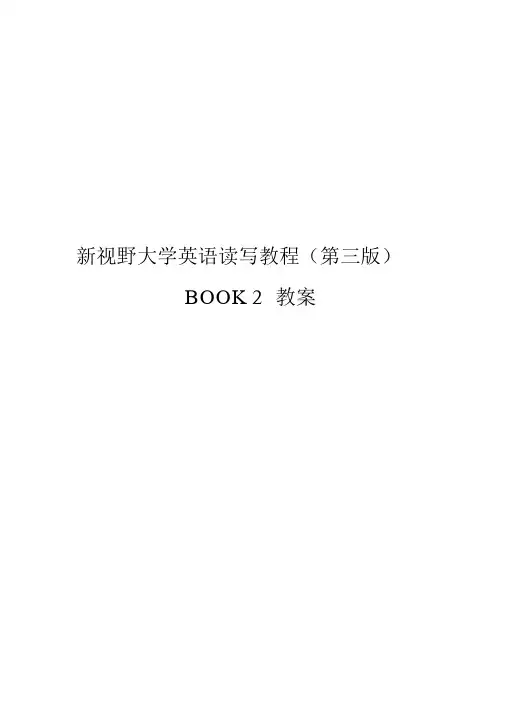
新视野大学英语读写教程(第三版)BOOK 2 教案教学对象Teaching Subjects 周次课型课时分配教学目标Teaching Aims重点Key Issues教学内容Unit 1 An Impressive English 2015 级大学英语本科LessonLesson Content第 2-4周授课时间2月 29日 -3月 18日□ 理论课√ 理论、实践课□ 实践课教学环境6Teaching多媒体教室EnvironmentAfter studying this unit, the students are expected to be able to:1.understand the main idea and structure of Section A and Section B ;2.master the key language points and grammatical structures in the texts3.talk about language teaching and learning and express their opinions about current way ofteaching in an English class;4. read with the skill finding key― ideas in sentences ‖;5.write a composition with three main parts: introduction, body and conclusion.1.Vocabularytedious absorbed allergic capture condense exceed distinguish distinctive complimentary complementary proclaim evidently adequate competent adjust beneficial2. Skills●Learn to read with the skill ―finding key ideas in sentences‖and write a composition withthree main parts: introduction, body and conclusion.难点● To talk aboutlanguage teaching and learningPotential Problems●write a composition with three main parts: introduction, body and conclusion.and Difficulties● To apply the phrases andpatternsA combination of traditional teaching methods with the communicative approach will beadopted. Special attention should be paid to classroom interaction like questioning and 教学方法answers. Small group works are always needed while discussing the questions and the Methodologydifficult translation practice. More encouragement is needed and more guidance will begiven in their extracurricular study.教具Teaching Visual aids, projector, stereo and microphoneAids教学分组Teaching Group work and pair workGroups课堂学习任务与活动的组织Conduct of Tasks and Activities(师生互动方式Mode of Interaction;学习策略Learning Strategies)Students-centeredTask-based teaching and learning教学过程设计Teaching Procedures步骤 1 Step 1导入Lead-inI.Greeting and warming-up questions discussion.1.What are the key factors that help people learn English as a foreign language?2.Do you have any problem in English learning?3.Do you think grammar is important in English learning?II.Listening and discussing.1.Listening practice.2.In your opinion, what is the most effective way to learn English?III.Listening to a talk and answer questions on page 2步骤 2 Step 2 课文学习Section A An Impressive English LessonI. New words1. tedious: a. boring and continuing for too long冗长乏味的Telling the story has become tedious, as I have done it so many times.讲述这个故事已变得单调乏味,因为我已经讲了这么多次了。
新视野大学英语第三版 book2unit3A教案
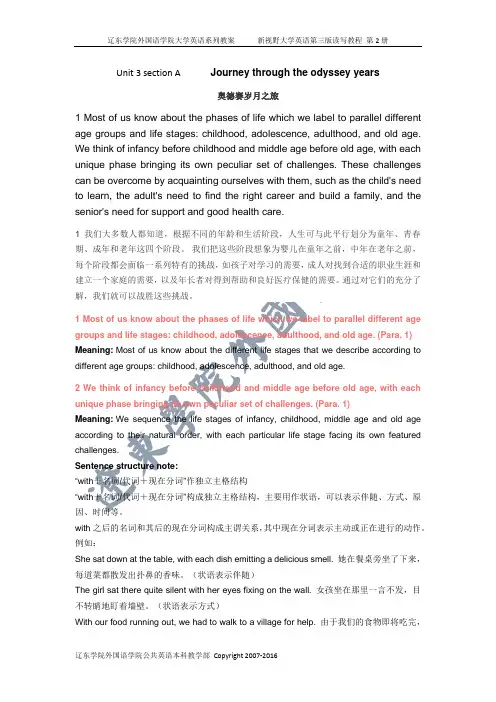
Unit 3 section A Journey through the odyssey years奥德赛岁月之旅1 Most of us know about the phases of life which we label to parallel different age groups and life stages: childhood, adolescence, adulthood, and old age. We think of infancy before childhood and middle age before old age, with each unique phase bringing its own peculiar set of challenges. These challenges can be overcome by acquainting ourselves with them, such as the child's need to learn, the adult's need to find the right career and build a family, and the senior's need for support and good health care.1 我们大多数人都知道,根据不同的年龄和生活阶段,人生可与此平行划分为童年、青春期、成年和老年这四个阶段。
我们把这些阶段想象为婴儿在童年之前,中年在老年之前,每个阶段都会面临一系列特有的挑战,如孩子对学习的需要,成人对找到合适的职业生涯和建立一个家庭的需要,以及年长者对得到帮助和良好医疗保健的需要。
通过对它们的充分了解,我们就可以战胜这些挑战。
1 Most of us know about the phases of life which we label to parallel different age groups and life stages: childhood, adolescence, adulthood, and old age. (Para. 1) Meaning: Most of us know about the different life stages that we describe according to different age groups: childhood, adolescence, adulthood, and old age.2 We think of infancy before childhood and middle age before old age, with each unique phase bringing its own peculiar set of challenges. (Para. 1)Meaning: We sequence the life stages of infancy, childhood, middle age and old age according to their natural order, with each particular life stage facing its own featured challenges.Sentence structure note:“with+名词/代词+现在分词”作独立主格结构“with+名词/代词+现在分词”构成独立主格结构,主要用作状语,可以表示伴随、方式、原因、时间等。
新视野第三版第二册读写教案
新视野大学英语教案
第二册 (第三版)
课题目(教学章节或主题) :
Unit 1 An Impressive English Lesson
教学目标或要求: Students are supposed to 1. think and talk about language teaching and learning 2. understand and know the main idea of the text 3. learn and apply words, phrases and sentence patterns 4. master the essay writing skill 教学重点、难点: Key points: 1. text understanding 2. language points Difficult points: 1. language use 2. writing skill application 教学进程(包括基本内容、环节、步骤) : 教学时数:6 学时 I. Pre-reading activities and text study (2 学时) II. Text study and essay writing (2 学时) III. Language focus and critical thinking (2 学时) 教学手段与方法: (Application of BOPPPS Model) 思考题、讨论题、作业: Do you think grammar is important in English learning? How can students enlarge their vocabulary? Write an essay using the writing model: introduction-body-conclusion. 教学过程: I. Pre-reading activities and text study 1. Bridge-in Idea-sharing: an unforgettable English lesson 2. Objective Students are required to: 1)think and talk about English teaching and learning 2)understand and know the main idea of the text 3. Pre-test Listen to a talk about an English learner’s learning experience and answer questions. 4. Participatory Learning (1) Pre-reading activities Discuss the following questions. a. In your opinion, what is the most effective way to learn English? b. What do you think is the most difficult in English learning? c. Do you think grammar is important in English learning? (2) Text understanding i. What does the son think of the father? (Para. 1)
新视野大学英语第三版读写教程第二册第一单元教案
大学英语(2)教案use English learning strategies consciously教学重难点Using proper language to talk about English learningHow to apply the reading skill – reading for the key idea in a sentence教学材料教学方法1. 教学材料:Text A课文、练习2. 教学方法:Under the guidance of student-centered principle, apply communicative and heuristic teaching methods, stimulate students’ interest in learning English and get students involved in class participation教学过程一、课前导入Talking about your experience of learning EnglishWatch the video clip and discuss the following question in pairs.1)According to the speaker, in what ways did Chinese students learn English?Chinese students practice their English by screaming it.2)Do you agree with what he said about Chinese students learning English? Why or why not.Yes, I just learned English exactly that way.No, we have learned English in different ways.3)How do you learn English? What do you think of your way of English learning?I learn English by:listening to the teacher carefully in classtaking notes …to go over lessons latercatching every chance to practice speakinglistening and reading a lotdoing enough exercises to practice grammar rulesI think my way of English learning is:effective, ineffective, interesting, boringchallenging but rewardingexamination-oriented二、文本学习1. Global understanding of the text1)Scan the text in three minutes and fill in the blanks.After I read the passage, I know the text talking about how _________ and __________ can be taught efficiently. The writer might be a ________ and a ________________ as well.2)What is the writing style of the text? Why?The writing style of the text is relaxed, which is proved by a lot of short sentences and paragraphs, casual verbs, daily talks and simple modifiers.3)Map the text structure and fill in the blanks.2. Detailed understanding of the textRead the text again and answer the following questions.1) Why does the son think that his father is a tedious oddity?Because he is tired of listening to his father and he is not interested in grammar rules.2) Why does the author think that students’ language deficits should be blamed on schools?Because the schools fail to set high standards of language proficiency. They only teach a little grammar and less advanced vocabulary. And the younger teachers themselves have little knowledge of the vital structures of language.3) What does the father teach the son while giving him a grammar lesson?He familiarized his son with different parts of speech in a sentence and discussed their specific grammatical functions including how to use adverbs to describe verbs.4) What are the two things that the author uses to describe grammar and vocabulary?The author uses “road map” and “car” to describe grammar and vocabulary. Here, “road map” is considered as grammar and “car” as vocabulary.5) How do you understand the interjection “whoa!” said by the father toward the end of the text?Since the subjunctive mood his son used is a fairly advanced grammar structure, the in terjection “whoa!” reflects the tremendous pride the father had toward his son; it also reflects the author’s humor in using the word because it was once used by his student, though in two different situations and with two different feelings.第二次课一、文本拓展1) Text SummaryAn Impressive English LessonTo my son, I am a _____________: a father he is __________ listen to and a man ____________ the rules of grammar. And I got ______________ this because my student was unable to describe properly her feeling on her __________ to Europe.However, it doesn’t ________________ to criticize our students. They unfairly bear the bulk of the criticism for these __________________ because there is a sense that they _________________. On one hand, they are misled by the____________. On the other hand, school fails to _________________ the essential framework of language, accurate grammar and proper vocabulary. Perhaps, language should be looked upon as a _________ and a ___________________: often study the road map (check grammar) and ________ the car engine (adjust vocabulary). Learning grammar and a good vocabulary is just like driving with a road map in a ________________ car. __________, _________, and __________ communication depends upon grammar and a good vocabulary, the two __________ assets for students, but they are ________________ in schools.2) Language Points3. Criticl thinking1)What do you think of the “impressive English lesson”? Is it effective?●Yes. Because the lesson aroused children’s interest in learning English grammar.●Yes. Because the way to learn grammar is more natural, interesting and enjoyable.●Yes, because learners become more motivated when learning something they like.●No. because it’s like a street learning without forma l instruction.2) Do you think English grammar helps you a lot in learning English? Why or why not?English grammar helps a lot:●Order sentences correctly.●Use words properly.●Talk with other English speakers confidentlyEnglish grammar is of little help:●Only give rules that are hard to remember.●It is not helpful in a real-life setting due to the limited time to think and recall the rules.●Not always applicable to the real language, especially idioms.3) How can you effectively enlarge your vocabulary?●Read more English from online sources.●Watch English TV / listen to English radio / watch English online videos.●Talk often with English speakers.●Listen carefully and extensively.●Use dictionaries to look up unfamiliar words.●Use new words as often as possible.二、写作训练 (P13)1)Structure AnalysisAs the name of our textbook implies, we read English in order to write in it. But how to write in the English way?As is known to all of us, what we write reflects what we think; and how we write mirrors how we think. In that light, our best way of writing in English is to know well how to think in English as the American or British people do. What is their way of thinking then?Different from us who think in the spiral way (螺旋式), they tend to think in the linear way (线性方式). As far as paragraph writing is concerned, deduction (演绎法) is typical of their linear way of thinking, as shown below:Starting from this book, you are moving from paragraph writing to short essay writing. In a likely manner, however, we will go through the same process for essay writing as we did for paragraph writing. In college writing, an essay normally has three main parts: introduction, body,What are minor details and what are the main ideas. (Many words in a sentence describe things about the subject of the sentence but they merely find the details to it. If we ask when, what, where, or why, we will find out these details, which further help us to see the key idea of the sentence.)4) What to keep in mind to find out the key idea of a sentence?Of course, we cannot always easily decide which details are simply descriptive and which add much to the key idea. However, the starting point for determining the key idea ina sentence is to find who or what the sentence is about and what the person or object isdoing.2. 文本学习1) Applying the reading skillWhat can the title “The Great Journey of Learning” tell us?The title “The Great Journey of Learning”, coupled with the topic “Language in Mission” of the unit, tells us the central idea—The process of learning has a profound effect on one’s life.2) Detailed understanding of the textRead Text B and choose the best answer to each of the questions (Page 24)Read the text again and think about the following questions:1. Why did Malcolm X want to learn English? (Para.2)Because he was poorly educated, he felt inadequate to teach his new beliefs to others.2. What motivated Malcolm X to launch on a quest to overcome his language deficiencies? Malcolm X’s considerable frustration at his inability to read and write launched him on a quest to overcome his deficiencies.3. How did Malcolm X move from basic literacy toward true proficiency? (Para. 5)He copied dictionary, read everything he had written aloud and logged important things that happened every day. Repetition helped move him from basic literacy toward true proficiency. 4. What did Malcolm X obtain from language learning? (Paras. 9-10) Reading had changed forever the course of Malcolm X’s life. As he acquired knowledge, his horizons expanded. He had left behind the narrow, ignorant world of his youth to join the world community of thoughts and actions ever since he started with his great journey of learning English in prison.3. 知识总结听说训练第四次课教学目的及要求Talk about learning experiencesListen for signal words for listingGive and respond to adviceTalk about learning / teaching methods教学过程1. Listening to the worldSharing1) Watch a podcast for its general idea.The podcast is mainly about the things people are learning at the moment and the most difficult thing they have ever learned.2) Watch Part 1 and fill in the blanks●new things●At the moment●quite difficult3) Watch Part 2 and check the true statements.ListeningListening skillsListening for signal words for listing●Listen for the total number of items at the beginning●Listen for words and expressions that signal the beginning, following and end of the listing⏹ e.g. the last, the final, lastly, and finally●Listing items with equal value⏹ e.g. to begin with, to start with, furthermore, moreover, in addition, besides, what’smore, the last but not the least, lastly, finally●Words and expressions indicating importance⏹expressions: above all, the most important / obvious / noteworthy⏹Adjectives: main, vital, significant, chief, central, principal, primary, major,distinctive, and the –est forms of adjectives1)Listen to a radio program and rearrange the following expressions.e-c-a-g-d-h-b-f2) Listen to the radio program again and complete the table.●speak●saying the wrong thing。
新视野大学英语口语2(第三版)完整教案
新视野大学英语口语2(第三版)完整教案课程概述本教案是针对《新视野大学英语口语2》(第三版)编写的完整教案。
该教材是为大学英语专业学生设计的口语教程,旨在培养学生的听说能力,提高其口语表达和交流能力。
教学目标- 提高学生的英语听力能力,使其能够更好地理解日常生活和研究中的口语表达;- 培养学生的口语交流能力,让其能够流利地进行简单的英语对话;- 培养学生的英语思维能力,使其能够更好地运用英语进行思考和表达。
教学内容本教案包含教学的各个环节和详细的教学内容安排。
具体包括以下几个方面:1. 教学方法:- 利用情景对话、角色扮演等互动活动提高学生的口语交流能力;- 通过听力练和口语训练提高学生的听说能力;- 引导学生进行小组讨论和演讲,培养其英语思维和表达能力。
2. 教学材料:- 使用《新视野大学英语口语2》(第三版)课本作为教学材料;- 准备相关的听力材料,用于提高学生的听力能力。
3. 教学内容安排:- 第一课:介绍课程概况,了解学生的英语水平和研究需求;- 第二课至第十五课:按照教材内容逐课进行教学,包括听力练、口语训练和互动活动;- 第十六课:进行口语测评和总结。
教学评估为了评估学生的口语表达和交流能力,可以采用以下评估方式:1. 口语测试:设计一套口语测试题目,测试学生的口语表达能力;2. 研究笔记:要求学生记录每堂课的重要内容和收获,评估学生的研究情况;3. 小组讨论和演讲:观察学生在小组讨论和演讲中的表现,评估其英语思维和表达能力。
教学辅助工具为了支持教学过程,可以使用以下教学辅助工具:1. 多媒体设备:使用投影仪、电脑和音响等设备播放课件和听力材料;2. 教学软件:利用电脑上的英语研究软件辅助学生的口语训练;3. 教学素材:准备相关的图片、视频和实物,用于情景模拟和角色扮演。
教学参考资源为了提供更全面的教学支持,可以参考以下资源:1. 课本答案与教师用书:获取课本答案和教师用书,了解教材的教学设计和示范教案;2. 口语教学参考书籍:查阅相关的口语教学参考书籍,获得更多的教学启示和教学方法;3. 在线研究资源:查找相关的在线研究资源,如网上课堂、研究社区等,为学生提供更多研究机会。
新视野大学英语2第三版B2U6教案
课程名称:新视野大学英语2教材版本:第三版单元名称:Unit 6 A Journey of a Thousand Miles Begins with a Single Step 课时:2课时教学目标:1. 理解课文主旨,掌握文章结构和段落大意。
2. 掌握课文中的重点词汇和短语。
3. 提高学生的阅读理解能力和英语写作能力。
4. 培养学生的跨文化交际意识。
教学重点:1. 课文中的重点词汇和短语。
2. 课文的写作手法和结构。
教学难点:1. 课文中的复杂句型。
2. 课文的深层含义。
教学过程:第一课时一、导入1. 教师简要介绍课文背景,激发学生的学习兴趣。
2. 学生自由讨论,谈谈自己对“千里之行,始于足下”这句话的理解。
二、阅读课文1. 学生快速阅读课文,了解文章大意。
2. 教师引导学生分析课文结构,讲解段落大意。
三、词汇教学1. 教师带领学生分析课文中的重点词汇,如:begin, step, journey, thousand, miles, single, etc.2. 学生练习使用这些词汇造句。
四、语法教学1. 教师讲解课文中的复杂句型,如:A journey of a thousand miles begins with a single step.2. 学生练习翻译这个句子。
五、总结1. 教师总结本节课的重点内容,强调学生的收获。
2. 学生分享自己的学习心得。
第二课时一、复习导入1. 教师提问学生关于课文内容的问题,检查学生对课文的理解程度。
2. 学生复述课文中的故事。
二、阅读理解1. 学生阅读课文,回答问题,检验自己的阅读理解能力。
2. 教师讲解课文中的深层含义,引导学生思考。
三、写作训练1. 教师布置写作任务,要求学生以“我的梦想之旅”为题,写一篇短文。
2. 学生写作,教师巡视指导。
四、课堂展示1. 学生展示自己的写作成果,其他学生给予评价。
2. 教师点评学生的写作,指出优点和不足。
五、总结1. 教师总结本节课的重点内容,强调学生的收获。
